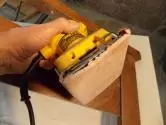To Sand Or Not To Sand . . . .

The Roycrofters only made 400 of these chairs for the hotel where, as you may know, we meet for the annual National Arts and Crafts Conference each February. In the years between 1919 and 1921, a total of 350 of these 400 chairs had arms added to them. The arms were made by the Roycrofters, shipped to Asheville, and attached by local woodworkers.
In 1955, during a major remodeling, the vast majority of the Roycroft chairs with the letters GPI carved across the back were sold for five dollars each to area residents. They ended up in homes, businesses, an elderly care facility, and a bar on Eagle Street, where I once had a beer trying fruitlessly to talk the owner out of a pair of them.
Once the Arts and Crafts Conference started coming to Asheville, the GPI chairs started appearing in local shops and auctions — and the prices for them began climbing. Some eventually made their way into important private and public Arts and Crafts collections, and soon what was once a steady stream turned into a trickle.
My most recent purchase cost me three times what I had paid for them twenty years ago, but I was still happy to get it — even though it came with some inappropriate upholstery and a thick, uneven coat of glossy 1960s polyurethane. The chair presented me with a question: do I strip off the glossy polyurethane — or sand it off?
Twenty years ago I would not have hesitated, reaching automatically for the heavy-duty paint remover. But today, faced with the thought of the mess, the fumes, and the inherent dangers with any chemical remover, I reconsidered. Instead I reached for my palm sander.
Normally I would never advise anyone to use a sander on an antique, for the fear is that if not used properly, sandpaper could remove the top layer of wood and the aged patina we cherish in antique furniture. What I decided, however, is that if I took the proper precautions and did not try to do too much too quickly, I could use the palm sander to save myself several hours of hand sanding or stripping off that thick layer of polyurethane.
If you are faced with a similar situation, let me pass along these tips:
1. A belt sander is not the same as a palm sander. Belt sanders can ruin an antique in seconds. The lightweight palm sanders, that take ¼ sheet of sandpaper rather than a belt of sandpaper, are lighter and safer to use.
2. Never use sandpaper more coarse than #150-grit. Coarse grits can tear through the old finish so quickly that you will be sanding off wood, and leaving ugly swirling marks behind.
3. As the #150-grit abrasive sands off the old polyurethane, it will create a fine, white powder. Stop sanding the instant you see sawdust. You will have penetrated through to the wood, at which point you should then switch to hand sanding with #220-grit sandpaper the rest of the way.
Let me emphasize that this technique is not one suited to any situation other than removing a thick layer of polyurethane finish. In other situations, using a chemical remover, such as denatured alcohol or lacquer thinner, may be safer for the valued patina in that top layer of wood.
Good Luck!
Bruce Johnson

